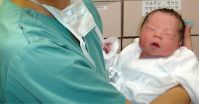(Press-News.org) Researchers at the University of Gothenburg have identified the biological clock that governs female fertility. The discovery represents a major contribution to research aimed at finding medical approaches to treating infertility in women.
Some women can have successful pregnancies at the age of 50, whereas other are unable to get pregnant when they are 30. Researchers are not yet able to fully explain such differences. One factor is that the onset of menopause is influenced by the point at which the uterus runs out of eggs to release.
A recent study at the University of Gothenburg sheds light on the mystery of the biological clock that governs fertility.
Just as newborn infants require nurturance in order to survive, eggs in the uterus need nourishment and support from the granulosa cells of the primary follicle. According to the latest discovery by Professor Kui Liu's research team, a signaling pathway in these cells plays a key role in enabling immature eggs to survive.
Pathways that determine the fate of an egg
The mTOR signaling pathway in the granulosa cells is necessary for activating expression of the kit ligand growth factor, which subsequently binds to the c-kit receptors of eggs and determines their fate.
According to Professor Liu, who is affiliated with the Department of Chemistry and Molecular Biology at the University of Gothenburg, "This mechanism permits the granulosa cells to decide when eggs will begin to grow and when they will die. In that sense, they serve as a kind of biological clock that monitors the onset of menopause."
Researchers believe that the discovery will point the way to interventions that stimulate the growth of eggs that have been unable to mature. Their hope is that increased knowledge about the molecular mechanisms that govern development in human eggs can be applied to clinical treatment of female infertility in the years to come. Professor Liu's team is plunging ahead with that goal in mind.
Professor Liu is affiliated with the Department of Chemistry and Molecular Biology at the University of Gothenburg. His team studies genetic and epigenetic regulation of the development of female gametes (sex cells). For the past few years, their efforts have focused on both basic preclinical research and the application of results generated by studies of mouse models to clinical techniques for the treatment of female infertility.
INFORMATION:
http://www.cell.com/current-biology/abstract/S0960-9822%2814%2901144-0 END
Identifying the biological clock that governs female fertility
2014-10-28
ELSE PRESS RELEASES FROM THIS DATE:
New insights into the development of ciliopathies
2014-10-28
"Epithelial cell layers line all of the inner and outer body and organ surfaces in the human body, for example in the lung, intestine, pancreas and in the inner ear," said Moritz Gegg. Cilia – small, hair-like, microtubule-based structures – project from BBs and are precisely positioned on many of these epithelial cells. "Only through this exact positioning can cilia movements be coordinated so precisely that for example mucus can be transported from the lung or sound can be perceived from sensory inner ear hair cells," added Heiko Lickert.
Cilia are anchored ...
Many home blood pressure monitors may be inaccurate
2014-10-28
Philadelphia, PA (October 28, 2014) — Home blood pressure monitors may be inaccurate in up to 15% of patients, according to a study that will be presented at ASN Kidney Week 2014 November 11¬–16 at the Pennsylvania Convention Center in Philadelphia, PA.
Major guidelines recommend home blood pressure monitoring to guide diagnosis and treatment of patients with hypertension; however, little is known about the real-world accuracy of home blood pressure monitors that patients use. Researchers led by Swapnil Hiremath, MD, MPH (Ottawa Hospital and University ...
NUS researchers discover for the first time that a rare bush frog breeds in bamboo
2014-10-28
Researchers from the National University of Singapore (NUS) have discovered a new reproductive mode in frogs and toads - breeding and laying direct developing eggs in live bamboo with narrow openings - which was observed in the white spotted bush frog (Raorchestes chalazodes). This critically endangered frog is currently only one of two species known to adopt this novel reproductive strategy. The findings were published in The Linnean Society of London's Biological Journal of the Linnean Society, in October 2014.
Life history strategies to increase reproductive success ...
Fish 'personality' linked to vulnerability to angling
2014-10-28
Individual differences in moving activity in a novel environment are linked to individual differences in vulnerability to angling, according to an experimental study completed at the University of Eastern Finland and the Finnish Game and Fisheries Research Institute. The study used novel, long-term observations of individual behaviour in groups and authentic angling trials to analyse if behaviours predict the vulnerability to fishing in brown trout reared in traditional and enriched hatchery rearing environments. Based on the results, it can be predicted that fishing modifies ...
When faced with higher prices, swimming is the activity most likely to take a dive
2014-10-28
Experts agree that it's a great way of staying fit and healthy at any age, but when faced with higher prices people are likely to swim less often, while other forms of physical activity such as working out or walking are barely affected.
According to a study by Brunel University London's Health Economics Research Group (HERG), swimming is the individual activity that most people would drop if they faced higher prices.
The study included interviews with 1,683 people, 83% of whom took part in physical activity in some form. It found that people facing 10% higher entry ...
Tea and citrus products could lower ovarian cancer risk, new UEA research finds
2014-10-28
Tea and citrus fruits and juices are associated with a lower risk of developing ovarian cancer, according to new research from the University of East Anglia (UEA).
Research published today reveals that women who consume foods containing flavonols and flavanones (both subclasses of dietary flavonoids) significantly decrease their risk of developing epithelial ovarian cancer, the fifth-leading cause of cancer death among women.
The research team studied the dietary habits of 171,940 women aged between 25 and 55 for more than three decades.
The team found that those ...
Generic medications boost adherence to breast cancer therapy
2014-10-28
VIDEO:
A study by Columbia University Medical Center (CUMC) researchers has found that the introduction of generic aromatase inhibitors (the most common type of hormone therapy), which are considerably less expensive...
Click here for more information.
NEW YORK, NY (October 27, 2014)—Although oral hormonal therapy is known to substantially reduce breast cancer recurrence in women with hormone receptor–positive tumors, about one-half of patients fail to take their medications ...
Chimps plan ahead for a good breakfast
2014-10-28
New research by the University of California, Davis, shows that chimpanzees plan ahead, and sometimes take dangerous risks, to get to the best breakfast buffet early.
The study co-authored by Leo Polansky, an associate researcher in the UC Davis anthropology department, reveals that chimpanzees will find a place to sleep en route to breakfast sites and risk travel in the dark when predators are active to obtain more desired, less abundant fruits such as figs. The study is being published by the Proceedings of the National Academy of Sciences of the United States of America.
"As ...
Replacing saturated fat with polyunsaturated fat linked with lower risk of heart disease
2014-10-28
Boston, MA — People who swap 5% of the calories they consume from saturated fat sources such as red meat and butter with foods containing linoleic acid—the main polyunsaturated fat found in vegetable oil, nuts, and seeds—lowered their risk of coronary heart disease (CHD) events by 9% and their risk of death from CHD by 13%, according to a new study led by Harvard School of Public Health (HSPH) researchers. Substitution of 5% of calories from carbohydrate with linoleic acid was associated with similar reductions in risk of heart disease.
"There has been ...
Don't bet on stinginess to keep stress low
2014-10-28
Is generosity less stressful than being stingy?
QUT research, published in scientific journal Public Library of Science (PLOS) ONE, examined the physiological reactions of participants in a financial bargaining game and found that not only those receiving relatively low offers experienced stress but also those that make low offers, when compared to people who made more generous offers.
Participants were asked to play the Ultimatum Bargaining Game, in which players decide how to divide a sum of money given to them.
Player one (the proposer) proposes how to divide ...



